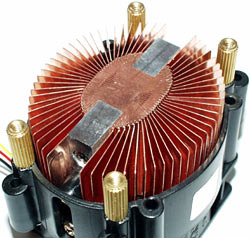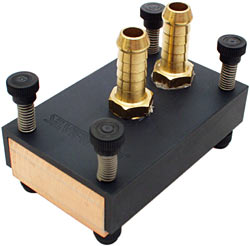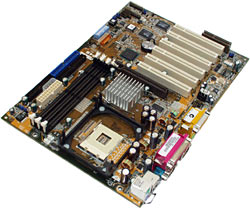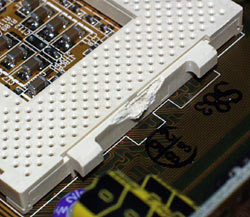
Atomic I/O letters column #9
Originally published in Atomic: Maximum Power Computing Reprinted here 11-Jun-2002.Last modified 16-Jan-2015.
Suspiciously easy...
I recently bought a 1.4GHz Athlon and an Asus A7M266 motherboard. After a few case mods, the CPU temp sensor was reading 31C on load and I decided to go to a few sites and learn how to overclock. On my first attempt, I went to the BIOS and raised the FSB speed. To my surprise the computer actually displayed a higher clock speed when it booted up.
I fiddled with the FSB, and each time I booted I got a higher number. I'm not sure if I've really overclocked my first machine, because it just seems too easy to be true.
In the forums I read that you had to unlock the CPU by joining the bridges using a pencil before it can be overclocked, and that you had to fiddle with the jumpers on the motherboard as well. But all I did was play with the BIOS, and got a higher clock speed.
Did I really, or does the clock speed reading at the boot screen mean absolutely nothing? Also, does a 1.4GHz Thunderbird need to be unlocked before overclocking?
Martin Tan
Answer:
FSB overclocking is that easy, at least on a motherboard that supports
software FSB adjustment - which most do, these days.
Unlocking an Athlon or Duron lets you change the multiplier - the ratio between the core speed and the FSB. Your 1400MHz CPU, for instance, has a 10.5X multiplier and a 133MHz FSB, by default.
Multiplier adjustment is a better way to overclock than by just winding up the FSB, because changing the multiplier doesn't increase the speed at which anything else in the computer has to run. Some modern motherboards let you increase the CPU FSB speed without tweaking up the PCI and RAM speeds as well, but not all of them do.
You only have to play with actual physical jumpers on the motherboard if your mobo requires that, for one of the three basic overclocking adjustments - FSB, multiplier and CPU voltage. Or if you over-overclock to the point where you can't get into the BIOS setup, and therefore have to use the Clear CMOS jumper to reset your BIOS settings to defaults.
Note that just because a motherboard doesn't have a given feature in the BIOS setup - multiplier adjustment, for instance - that doesn't mean it'll have jumpers to do that job. Many motherboards lack one or more of the three overclocking tweaks.
Must go slower.
I want to make my PC run slower (please don't smite me!). Yeah, yeah, we've heard about Mr. Demonboy wanting 666MHz but that's not what I mean. I've just bought Commandos on budget price and it runs blisteringly fast on my Duron 700. The game's minimum specs are Pentium 133. How can I clock back my CPU to run this game at reasonable speed? Are emulators any good for this and if so, which one?
Daniel Purcell
Answer:
You're going to be amazed to hear this, but there are no PC emulators for
the PC. Well, OK, there are
at least
three, but they're probably not what
you want. Quite apart from their complexity, they're likely to still be
too fast for a lot of old games, if you run them on current hardware.
[UPDATE: It's been years since this page first went up, and DOSBox now solves this problem very nicely. It's an emulator specifically created to make old DOS games playable on modern PCs.]
Fortunately, there are modern-day versions of the programs that started coming out when turning off the "Turbo" switch (yes, those things used to do something) on your steaming new 40MHz 80386 was no longer enough to get DeathTrack down to a tolerable speed.
There's a good page about slowdown utilities here.
Can ASIO read your pr0n?
I recently heard on the radio that every couple of years the military destroy their hard disks, rather than simply delete the information stored on them. Apparently the information is retrievable even after it has been deleted because "there are different levels of deletion".
Does this apply to regular hard drives? If so, does that mean that files I deleted years ago are still on there and retrievable? If so, is it possible to have a blank hard disk full of nothing but ex-deleted files?
Alex Wong

A scanning tunnelling microscope. It can read overwritten data on
a hard drive.
This is not a practical alternative to making backups.
Answer:
Yup, various military organisations physically destroy storage devices they
don't want to use any more - by melting, sawing, shredding, acid baths and
other entertaining means. Possibly even by telling a class of kindergarten
kids that there's something interesting inside the drive. And yes, that's
because it is otherwise possible to recover data, even after it's been overwritten.
This is not like undeleting - recovering data that hasn't been overwritten yet. You can do that with a simple piece of software. Overwritten data can't be read normally by a drive, but the drive's own read heads can be used to recover data that's only been overwritten one or two times. To do that, you have to hook specialised sensor gear up to the heads, instead of using the standard read electronics.
For anything better than that, the drive platters have to be read by more sensitive, and fabulously expensive, equipment. Like a scanning tunnelling microscope, for instance.
You can read all about this, and about several other devious strategies that were the state of the art five years ago, here.
In answer to your question - files you deleted years ago are gone, even if you do have an STM lab in your garage. Assuming that your drive's been used normally over those years, any space that was marked free long ago will most likely have been used, and re-used, and re-re-used, many many times since then.
A mil-spook friend of mine cheerfully sent me pictures of a multi-DSP box they can use to, for instance, read what a laser printer inside a building is printing by monitoring the noise it creates on the mains supply wires going into the place. In real time.
He wouldn't say what they actually used that thing for, but the places that keep that sort of hardware buzzing away in the corner probably wouldn't have much trouble getting hold of a scanning tunnelling microscope with which to cast an eye over your drive. If you gave them reason to.
But if you've overwritten the data a mere 20 times, I'd be pretty darn startled if anybody on the planet could recover it. Ten times is probably well past the point of no return.
If you're nervous about the NSA reading your transcripts of what the Voices have been telling you, by the way, there are utilities that'll multi-overwrite data with random hash. Eraser, for instance.
Fuzzyvision
My Dad has found an old monitor in store room of his school and it's an NEC MultiSync XV17+. Because it was in the store room it obviously had to be broken or damaged in some way, but I'm hoping it can be fixed. The only problem is when I turn it on the picture is very blurry. I have tried degaussing it but nothing seemed to happen.
I think the problem is that it has been exposed to an excessive amount of electromagnetic radiation. The last LAN I went to there was a high voltage power cable running through the wall which made everyone's monitor go fuzzy in the way that this monitor is behaving now.
Nathan Dimbleby
Answer:
Degaussing won't affect blurriness. You, sir, have a focus problem.
Many current monitors have a hardware focus control somewhere inside the monitor, and software focus control accessible via the on-screen menus. Many older monitors, including your XV17+, have hardware focus controls that you can access without opening the monitor case.
That's good, because opening a monitor case when you're not quite sure what you're doing is a leading cause of leaping high in the air while punching yourself in the face with both fists and having a cardiac arrest.
Hardware focus controls are cool. All you need is a long, thin Philips screwdriver and five seconds alone with the monitor, and you can turn anybody's screen into an un-viewable fuzzy mess. Or, often, turn a nasty old fuzzy monitor into something that looks halfway OK.
On one side of the XV17+, you ought to see a couple of holes. One of them should have the horizontal focus adjust potentiometer at the bottom of it, and the other one should be for vertical focus. Tweak 'em and see if it helps.
NOTE: While focus-adjust holes are, obviously, meant to have screwdrivers poked into them, you're supposed to use a non-conductive plastic or ceramic screwdriver, or a very seriously insulated metal one.
I make no guarantees about how easy it might be for someone fishing around inside a monitor with a poorly insulated metal screwdriver to touch something connected to the high tension side of the flyback transformer. It ought to be difficult or impossible, but if you suddenly turn into a golliwog and fly across the room, don't blame me. And don't leave instructions to your next of kin saying they should blame me, either.
Free motherboard! For a reason!
I was recently given a Super7 motherboard, and had grand plans of building the backup system from hell, only to discover that the obvious reason it had been palmed off to me was that the lug on the outside middle edge of the socket had been snapped off. I was looking forward to doing some CPU freezing to see if I can get a P166MMX up to 330MHz or higher - it currently pulls 250MHz with a Cooler Master Athlon cooler @ 43 degrees Celsius.
Is there any way to repair the snapped lug? I once stumbled across a suitable method, and thought I'd never need it (stupid me), and promptly lost the link.
I almost forgot, the Motherboard is a: 5MVP3 Rev: 4.0, I'm not sure which manufacturer, but it has a Via chipset.
Adam Keast
Answer:
Since many high-clamping-force CPU coolers attach using just the middle
retention hook on either side of a CPU socket, and since the
fibre-reinforced
plastic the sockets are made of is very tough but not indestructible, this
problem is not an uncommon one. Especially for people who remove and reattach
a CPU cooler several times.
Schemes to repair snapped lugs vary from the merely gimcrack to the completely W. Heath Robinson; the one you're thinking of might be this.
There are five other ways to address this problem.
Solution one: Buy a new motherboard. Hey, it's a solution. Shut up.
Solution two: Install a new socket. It is possible, though not simple, to remove the whole socket and replace it with a new one. It's easier to do this to a Socket 7/Super7 mobo than a newer one, because the older CPU types have fewer pins. But it's still not easy. Doing it without a good solder/desolder station is less than fun, and doing it without appropriate soldering skillz is impossible. But it can be, and has been, done. I know a guy who did it. And he's in the Air Force, so he can't be that smart.
Solution three: If your socket still has outer mounting hooks - in other words, if there were originally three hooks on each side of the socket, but now you've lost the middle one on one side - then get a CPU cooler that's made to engage all three hooks. Like, for instance, any of Thermaltake's later-model "Orb" coolers. Such a cooler will be OK engaging only two hooks.
Unfortunately, your board's socket (which is the same size, for cooler mounting purposes, as Socket 370 or Socket A) has the two-hooks-per-side design.
Solution four: If your motherboard has mounting holes around the CPU socket, get a CPU cooler that can mount through those holes.

A Zalman CNPS5000-Plus CPU
cooler, which mounts using through-the-motherboard bolts.
Many top-end overclockers' coolers and water blocks use the bolt-mount method, precisely in order to avoid ripping lugs off sockets with their monster bulk. And water cooling is not a bad idea if you're experimenting with cryogenic CPUs.

A Silverprop Cyclone water
block, showing off more mounting bolts.
Of course, your motherboard doesn't have mounting holes, either, so that's out for you.
If you're wondering how I know all about your motherboard, it's because my spider-sense tells me it's a Lucky Star - and, when I first looked it up, Lucky Star still had a page for it. They don't seem to, any more.
Solution five: Thermal-glue a cooler to the CPU. If you attach the cooler (or water block) slightly off-centre then you'll still be able to work the Zero Insertion Force socket lever. And the flat-topped P-166 won't mind having something stuck to it with aluminium-loaded epoxy, or your choice of other thermal adhesive.
Now with extra wooziness!
Ever since I bought my first copy of Half-Life, I began noticing that as I was playing the game I started to feel nauseous and dizzy. After 10 minutes I had to turn the game off and go lie down because I was going to faint. I was just unable to play it.
I thought it was only that game, but recently I hired Gunman Chronicles, which uses the Half-Life engine, and the same thing happened to me. I just felt sick and wanting to throw up. But I have no problems with any other first person shooter games.
I was just wondering if anyone out there has ever had the same problem, and if you guys know what causes a game to make someone feel this way.
Nemisis
Answer:
Some people feel sick when they play any 3D games; others get touched off
by one or another game in particular. If you played every 3D game that ever
there was, you'd probably manage to find a few others that made you feel
woozy.
This problem's most likely to be caused by your cranial firmware. It might be curable with a mere OS update (be careful you don't accidentally install a peculiar religion while you're changing your fundamental beliefs). But if it's fixable at all on your model of brain, you'll probably need to update your BIOS. Since humans more than five years old aren't likely to have a flashable brain-BIOS, you'll have to replace the physical chip.
Updating a socketed brain-BIOS is a pretty simple procedure. But you may want to put some newspaper down first.
R2-D2 dialects
Why is it so hard for freaken mother board manufacturers to come together, sit down, and decide on a set of standard beep codes for motherboards?
I mean really, is it that hard?
I hate trying to figure out what the problem with an unbootable system is when each motherboard has its unique set of beep code meanings, and I mean really... who the hell can find their motherboard manual when they want it?
So my question is, are there any plans for the future when motherboard manufacturers finally decide on a standard set of beep codes?
┼PoLLYo|\| :
Answer:
AMI, Award,
Phoenix and
IBM (and some other less important BIOS
makers) never managed to reach agreement over a standard set of codes, back
in the day when all PCs reported missing video cards and stuffed RAM and
similar fundamental startup problems with vaguely Morse Code-ish beep sequences.
Heck, none of those companies even managed to agree within themselves
on a code set; different BIOSes from the one company can have different
beep codes.
That's an open platform for you, though. If it doesn't cause actual incompatibility or cause customers to smash your office windows in the middle of the night, nobody gives much of a damn about it.
If you want to decode the beeps and you've lost your paper manual, you may be able to find a cheat sheet on the motherboard manufacturer's site. You can usually find a PDF format manual for download these days, too. That doesn't help you if you've got an elderly motherboard, or if the computer that doesn't work is your only PC, of course.

The Asus P4B - An Incredible Talking Motherboard!
There's hope, though. Most motherboards still beep for errors, but there are other solutions now. Some boards these days use diagnostic LEDs. These aren't any better than beeps, because you still have to look up the number on the two digit display or the light pattern on the little stack of red/greed LEDs. Other boards, though, like the Asus P4B, speak their errors instead of beeping them, and can do so in several languages.
So, as long as nobody's set your mobo to Espanol and left you wondering what "mi aerodeslizador es lleno de anguilas" means, it's now possible to tell that the board thinks its CPU is toast without looking up "BEEEEEP-bip-bip-honk".
Finding out whether the CPU really is toast is, of course, another matter. But every little bit helps.



